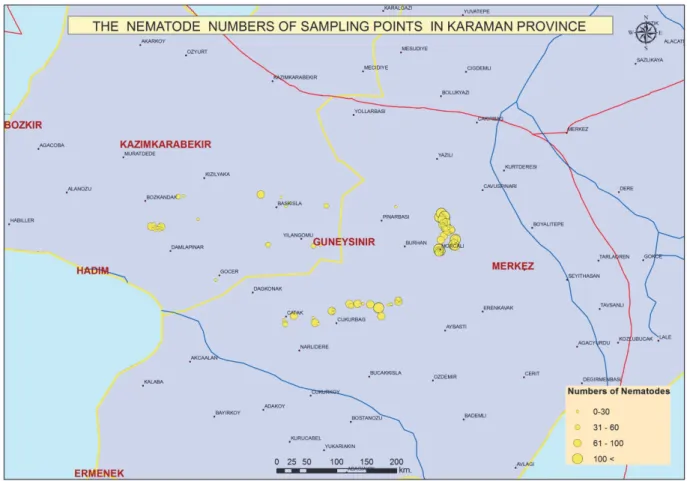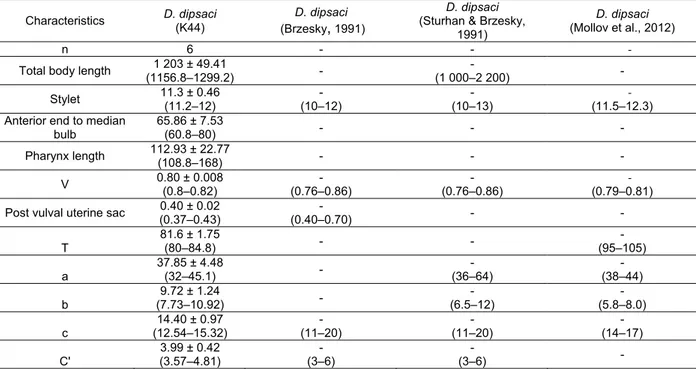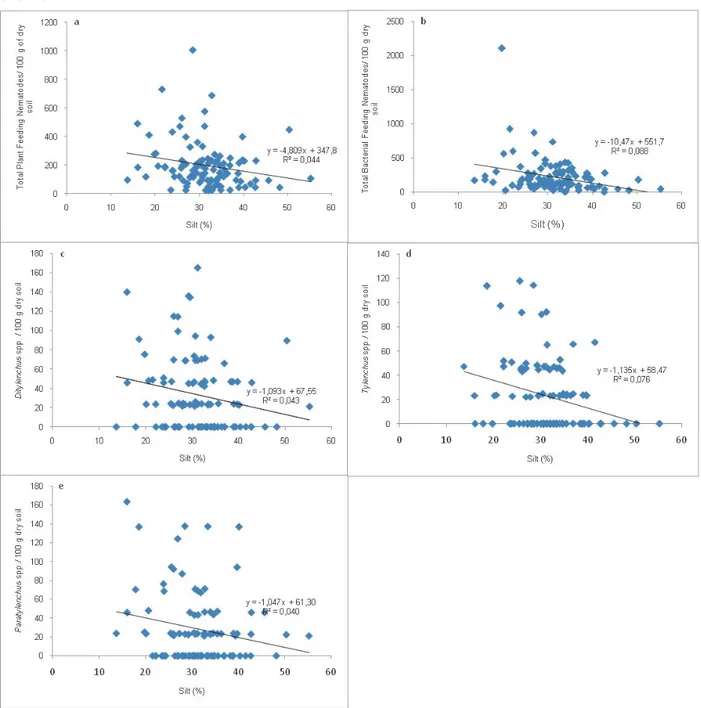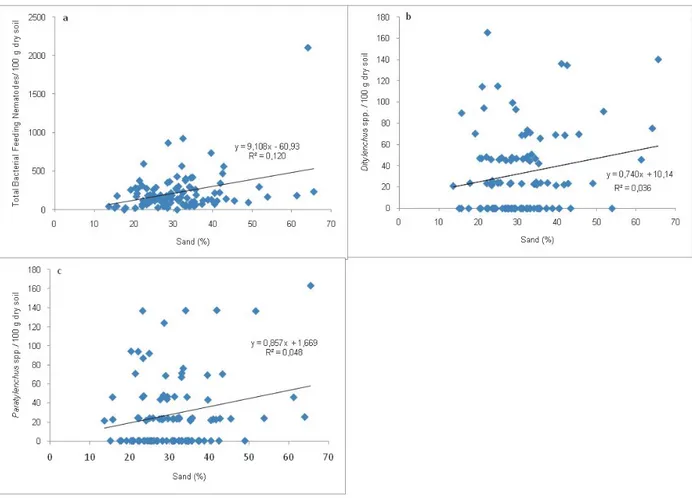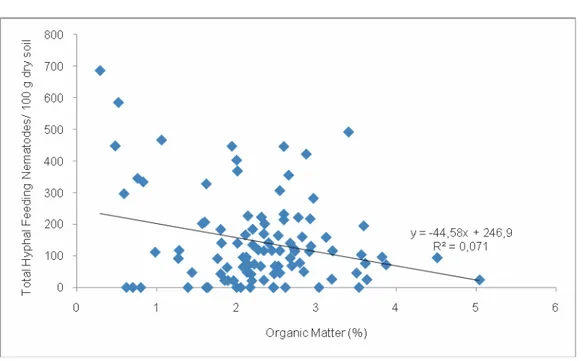Türk. entomol. derg., 2015, 39 (3): 251-259 DOI: http://dx.doi.org/10.16970/ted.48085
ISSN 1010-6960
Orijinal araştırma (Original article)
Distribution of nematodes on onion and their relationship with soil
physicochemical characteristics in Karaman province, Turkey
1,2Türkiye Karaman ilinde soğan ekiliş alanlarında bulunan nematodların dağılımı ve
toprak fizikokimyasal özellikleri ile ilişkileri
Elif YAVUZASLANOGLU
3* Abdullah DIKICI
4İ. Halil ELEKCIOGLU
5Metin AYDOGDU
6Summary
The distribution of plant-parasitic and free-living nematodes on onion rhizospheres and plant material and their relationship with soil physicochemical properties was investigated in Karaman province. Plant and soil samples totalling 100 were collected from onion fields during July, 2012. Nematode population density per three plants and 100 g of dry soil were determined for each sample. Ditylenchus dipsaci (Kühn 1857) (Tylenchida: Anguinidae) was found in 15% of plants and 61% of soil samples. Nematode numbers ranged between 0 and 140 (mean: 5) nematodes/three plants and 0–165 (mean: 33) nematodes/100 g dry soil. Other abundant plant-parasitic nematode genera were Paratylenchus (Micoletzky 1922) (Tylenchida: Paratylenchidae) (56%) and Tylenchus (Bastian 1865) (Tylenchida: Tylenchidae) (49%). The most abundant free-living nematodes were bacterivorous nematodes, which were found in 98% of samples, and were dominated by the Cephalobus (Bastian 1863) (Rhabditida: Cephalobidae) and Eucephalobus (Steiner 1936) (Rhabditida: Cephalobidae) genera. The majority of soil samples (68%) contained fungivorous nematodes belonging to the Aphelenchus (Bastian 1865) (Aphelenchida: Aphelenchidae) and
Aphelenchoides (Fischer 1894) (Aphelenchida: Aphelenchoididae) genera. Omnivorous nematodes in the Dorilaimida
order were found in 23% of soil samples. The distribution of plant- and bacterial-feeding nematodes were negatively related to the soil silt content and positively related to the soil sand content. Hyphal-feeding nematodes were negatively related to soil organic matter.
Keywords: Nematode, onion, soil physicochemicalcharacteristics, Karaman
Özet
Soğan ekiliş alanlarındaki bitki paraziti ve serbest yaşayan nematodlar tespit edilmiş ve toprak fizikokimyasal özellikleriyle ilişkileri araştırılmıştır. Yüz soğan ekili alandan 2012 Temmuz ayında 100 adet bitki ve toprak örneği alınmıştır. Nematod sayıları 3 bitki başına ve 100 g kuru topraktaki nematod sayısı olarak verilmiştir. Ditylenchus
dipsaci (Kühn 1857) (Tylenchida: Anguinidae) bitki örneklerinin %15’inde, toprak örneklerinin %61’inde bulunmuştur.
Nematod sayıları 3 bitki başına 0-140 nematod, ortalama olarak 5 nematod, 100 g toprakta ise 0-165 arasında ortalama olarak 33 nematod olarak tespit edilmiştir. Paratylenchus (Micoletzky 1922) (Tylenchida: Paratylenchidae) (56%) ve Tylenchus (Bastian 1865) (Tylenchida: Tylenchidae) (49%) türleri yoğun olarak bulunan diğer bitki paraziti nematodlardır. Serbest yaşayan nematodlar içinde en yüksek %98 oranında bulunan bakterivor nematodlar içinde en fazla bulunan cinsler Cephalobus (Bastian 1863) (Rhabditida: Cephalobidae) ve Eucephalobus’(Steiner 1936) (Rhabditida: Cephalobidae) dur. Aphelenchus (Bastian 1865) (Aphelenchida: Aphelenchidae) ve Aphelenchoides (Fischer 1894) (Aphelenchida: Aphelenchoididae) cinslerine ait fungivor nematodlar örneklerin %86’sında bulunmuştur. Dorylaimida takımına ait omnivor nematodlar, örneklerin %23’ünde bulunmuştur. Bitki paraziti ve bakterivor nematodların dağılımı toprak mil içeriği ile ters ve kum içeriği ile doğrusal bir ilişki içerisindedir. Fungivor nematodlar ise toprak organik madde yoğunluğu ile negatif ilişki göstermiştir.
Anahtar sözcükler: Nematod, soğan, toprak fizikokimyasal özellikleri, Karaman
1 This study was undertaken as a part of research project supported by TUBİTAK (Project number: TUBİTAK 111O222, 2011-2014) 2 This study was presented in International ESN Symposium in 23-27 September 2012 in Adana, Turkey and the abstract was
published in the congress proceedings book.
3Karamanoğlu Mehmetbey Univ., Technical Sciences Vocational School, Dept. of Plant and Animal Production, Karaman, Turkey 4Karamanoğlu Mehmetbey University, Institute of Science, Karaman, Turkey
5 Cukurova University, Faculty of Agriculture, Department of Plant Protection, Adana, Turkey
6Ministry of Food Agriculture and Animal Production, Central Research Institute for Field Crops, Department of Geographic
Information Systems, Ankara, Turkey
* Sorumlu yazar (Corresponding author) e-mail: eyavuzaslanoglu@kmu.edu.tr
Introduction
The onion is a vegetable, which plays an important role in human nutrition. Turkey is currently the seventh largest onion producer after China, India, USA, Iran, the Russian Federation and Egypt (Anonymous, 2014a). During 2012, the total area under onion cultivation in Turkey was 63000ha and total annual production was 1819000tonnes (Anonymous, 2014a). Most production occurs in the Amasya province, followed by Ankara, Hatay, Tokat, Eskisehir, Corum, Adana and Bursa provinces in the Central Anatolian, East Mediterranean, Middle Black Sea and Trace Regions. Climatic conditions are favourable for onion production in Karaman province, with a production area of approximately 1000ha providing 12657tonnes of onions during 2012 in Karaman (Anonymous, 2014b).
In addition to physiological disorders, diseases and pests compromise onion production. Plant-parasitic nematodes cause between 8.8 and 14.6% annual global crop losses (Nicol et al., 2011). The stem and bulb nematode, Ditylenchus dipsaci (Kühn 1857) (Tylenchida: Anguinidae) is a considerable constraint on onion production in Turkey. D.dipsaci was first isolated from onion plants in the Central
Anatolian region by Yüksel (1958). Saltukoglu (1974) recorded D.dipsaci on onion plants in the Istanbul
province. Ditylenchusdipsaci was recently recorded in the Konya, Karaman and Nevsehir onion-growing
areas (Oztürk, 1990). D.dipsaci is currently on the European and Mediterranean Plant Protection
Organization (EPPO) quarantine A2 list (No: 174), and has a local distribution in EPPO countries (Anonymous, 2014c).
Ditylenchus dipsaci results in stunting, discolouration and curving of leaves, local lesions and
misshapen bulbs in plants and correspondingly, results in yield losses and reduction in market value (Anonymous, 2011a). Economic yield losses were calculated to occur at concentrations of the nematode of ten or more per 400 cm3 soil (Seinhorst, 1956). Yield losses of 60–80% were recorded in soils heavily
infested by D. dipsaci (Nickle, 1991). In addition, it has been shown that D. dipsaci infestation resulted in 5–100% yield loss of onion and bulbous plants in the Aegean region (Anonymous, 2011b). It has been reported that 54.09% of onion fields in the Suluova district of Amasya province were infected by
D. dipsaci, and an average of 65% yield reduction was recorded (Mennan & Ecevit, 2002).
Ditylenchus dipsaci was reviewed to be distributed in both heavy and light soils, although a higher
incidence of disease severity was associated with heavy soils (Seinhorst, 1956; Miyagawa & Lear, 1970; Elgin et al., 1975; Sikora & Fernandez, 2005). Movement and dispersal of D. dipsaci tend to be greater in sandy soils than in clay soils (Elgin et al., 1975). Gerasimow (1954) found that the activity of D. dipsaci juveniles was dependent on the soil texture and pH. Activity of the juveniles was found to be higher in sandy soils at pH 7 and in loamy soils at pH 5.
Information on the distribution of nematodes as well as the damage caused on host plants requires urgent revision. Therefore, the aim of this study was to investigate the distribution of nematodes in the onion growing area in Karaman, the potential damage they may cause to onion cultivation and their relationship with soil physicochemical characteristics.
Materials and Methods
Sampling
Plant and soil samples totalling 100 were collected from onion fields located 1–2 km apart in the central Karaman, Ayranci and Ermenek districts from June to July during 2012. Sampling locations were recorded by a global positioning system (GPS). Sampling was performed in a zigzag pattern by taking a soil core sample using a 2.5 cm diameter width auger of 20 cm depth every 15 footsteps in the field. An average of 2 kg (2 000 cc) of soil was collected in total from 15–20 cores taken from each field. Three onion plants were sampled from each field using the same pattern.
Soil physicochemical analysis
Soil samples were analysed for pH, electrical conductivity (EC), CaCO3 and phosphorus (P)
contents, organic matter and texture. PH and EC (µS/cm) analyses were conducted according to the 1:2.5 soil: water ratio methodology described by Richards (1954). The CaCO3 content (%) was analysed
using the Scheibler calcimeter (Caglar, 1949). The P content (mg/kg) of soil samples was determined using the Olsen methodology (Knudsen, 1975). Organic matter (%) was determined using the Walkley– Black method (Walkley, 1946). Sand, silt and clay contents (%) were fractionated using the Bouyoucos hydrometer methodology (Tüzüner, 1990).
Nematode extraction and identification
Nematodes were extracted from three plants and 100 g fresh soil from each sample using the ‘Modified Baermann Funnel Technique’ (Hooper, 1986a). Extracted nematodes were counted under a light microscope at 40× magnification in 50 µl nematode suspension. The total number of nematodes in a 1 ml whole sample was calculated by multiplying the number of nematodes in 50 µl by 20. The soil moisture of each sample was calculated from the weight difference between fresh soil and soil dried at 90°C for one night. Nematode numbers were presented in 100 g of dry soil considering the soil moisture of each sample. Nematode genera were grouped according to trophic habits as described by Yeates et al. (1993). Permanent slides of the plant parasitic nematodes were prepared from all available specimens according to Hooper (1986b). Identification of the specimens was performed according to morphological and morphometric characteristics.
Statistical analyses
Soil physicochemical characteristics and nematode numbers were analysed using distribution analysis. The mean, maximum and minimum values were calculated for all variables, and the frequency of the soil texture class was determined. ANOVA was used to determine the frequency and population densities of nematodes and the student’s t-test was used to determine the statistical differences between the nematode genera and trophic groups. Regression relationships among soil physicochemical characteristics and soil nematode populations were investigated using multivariate correlation analysis.
Results and discussion
Physicochemical characteristics of soils
Soil pH of collected samples ranged between 6.69 and 7.88, with a mean of 7.60. EC of soils ranged from 70.70 to 274 µS/cm with a mean of 146.71 µS/cm. Soil physicochemical characteristics were evaluated according to standard values for soil fertility (Anonymous, 2013). The soil reaction changed the pH from neutral to weak alkaline. No problematic salinity levels were detected in any of the samples. Most samples had a high CaCO3 content (range: 0.88–67.8%, mean: 24.07%). The soil P content was
relatively high in all samples, with the lowest and highest being 3.23 mg/kg and 212.2 mg/kg, respectively (mean: 27.26 mg/kg). Most of the samples had low organic matter content, with the highest and lowest being 5.04% and 0.29%, respectively, in sampled soils. Mean organic matter content of the soil samples was 2.21%. The highest values of clay, silt and sand fractions were 55.29%, 55.29% and 65.69% and the lowest values were 16.11%, 13.67% and 13.67%, respectively. Mean clay, silt and sand contents were 35.45%, 33.13% and 31.23%, respectively. Most of the samples were clay loam (48%) and clay soil (34%). The frequency of sandy clay loam soil was relatively low (18%).
Frequency and population densities of nematodes
Nematodes obtained from the onion-planting areas were of the orders Tylenchida (Thorne 1949), Aphelenchida (Siddiqi 1980), Dorylaimida (Pearse 1942) and Rhabditida (Chitwood 1933). Identified trophic groups were plant-parasitic, hyphal-feeding, bacterial-feeding and omnivorous nematodes. Bacterial and plant-parasitic nematodes were at the highest frequency and population densities in sampled soils. Hyphal-feeding nematodes were grouped as having medium occurrence and population density. The lowest occurrence and population densities were obtained for omnivorous nematodes (P < 0.05).
Plant-parasitic nematodes were obtained from all samples. The mean population density of plant-parasitic nematodes was 196 nematodes/100 g of dry soil (range: 21–687 nematodes/100 g of dry soil). The most frequently obtained plant-parasitic nematodes were D. dipsaci, Tylenchus spp. and
Paratylenchus spp.
The isolation frequency of D. dipsaci was 61%, which was significantly higher among plant-parasitic nematodes (P < 0.05). The population density of D. dipsaci varied between 0 and 165 nematodes per 100 g of dry soil (mean: 33 nematodes/100 g of dry soil). D. dipsaci was found in 15% of plant samples, with a population density of between 0 and 140 nematodes/three plants (mean: four nematodes/three plants). Figure 1 shows the distribution of D. dipsaci in soil of Karaman province according to population densities in sampling points. The population densities of D. dipsaci in soil samples were very high, with more than 100 nematodes/100 g of dry soil at the central villages of Morcali and Cukurbag. This area is irrigated and cultivated intensively for onion cultivation, and consequently, the higher D. dipsaci population densities were expected. In contrast, Damlapinar, Kizilyaka, Bozkondak and Baskisla are areas of non-irrigated onion production, where D. dipsaci was found at low frequency and population densities.
Figure 1. Distribution of Ditylenchus dipsaci based on population densities in soil in Karaman province during July 2012.
The second frequently identified genus belonging to plant parasitic nematodes was Paratylenchus, which was isolated from 56% of soil samples. The mean population density in sampled fields was 28 nematodes/100 g of dry soil, in a range of 0–163 nematodes/100 g of dry soil
Tylenchus spp. was found in 49% of collected soil samples. The population density of Tylenchus spp.
Aphelenchus and Aphelenchoides are hyphal-feeding nematode genera that were found at a rate
of occurrence of 74% and 76%, respectively, and their mean population densities were 65 (range: 0–355) and 79 (range: 0–335) nematodes/100 g of dry soil, respectively. There was no significant difference between population densities of feeding nematode genera found. The occurrence of total hyphal-feeding nematodes was 86%, with a population range of 0–686 nematodes/100 g of dry soil (mean: 145 nematodes/100 g of dry soil).
The most abundant bacterial-feeding nematode genera was Cephalobus (86%; P < 0.05), followed by Eucephalobus (69%). The density of populations ranged between 0 and 446 nematodes/100 g of dry soil (mean: 81 nematodes/100 g of dry soil) and 0–2055 nematodes/100 g of dry soil (mean: 77 nematodes/100 g of dry soil) for Cephalobus and Eucephalobus genera, respectively. Total isolation frequency of bacterial-feeding nematodes was 98%, with population densities ranging between 0–2 105 nematodes/100 g of dry soil (mean: 223 nematodes/100 g of dry soil).
The frequency of omnivorous nematodes was 23% and populations ranged between 0 and 114 nematodes/100 g of dry soil (mean: 10 nematodes/100 g of dry soil).
Species identification of key plant
-
parasitic nematodesDitylenchus spp. includes migratory endoparasitic and hyphal-feeding nematodes (Yeates et al.,
1993). Morphological identification of specimens obtained from plant samples showed that the specimens belonged to D. dipsaci species (Brezeski, 1991; Sturhan & Brzesky, 1991; Mollov et al., 2012). Morphometrical and allometrical measurements for the investigated specimens in comparison with the literature are presented in Table 1.
Table 1. Morphometric characteristics of Ditylenchus dipsaci collected from onion plant material
.
Measurements in µm and brackets indicate the mean ± standard error (range) (isolate K44)Characteristics D. dipsaci (K44) D. dipsaci (Brzesky, 1991)
D. dipsaci
(Sturhan & Brzesky, 1991)
D. dipsaci
(Mollov et al., 2012)
n 6 - - ‐
Total body length (1156.8–1299.2) 1 203 ± 49.41 - (1 000–2 200) - - Stylet 11.3 ± 0.46 (11.2–12) (10–12) - (10–13) - (11.5–12.3) ‐ Anterior end to median
bulb
65.86 ± 7.53
(60.8–80) - - -
Pharynx length 112.93 ± 22.77 (108.8–168) - - -
V 0.80 ± 0.008 (0.8–0.82) (0.76–0.86) - (0.76–0.86) - (0.79–0.81) ‐
Post vulval uterine sac (0.37–0.43) 0.40 ± 0.02 (0.40–0.70) - - -
T 81.6 ± 1.75 (80–84.8) - - - (95–105) a 37.85 ± 4.48 (32–45.1) - - (36–64) - (38–44) b 9.72 ± 1.24 (7.73–10.92) - (6.5–12) - (5.8–8.0) - c 14.40 ± 0.97 (12.54–15.32) - (11–20) - (11–20) - (14–17) C' 3.99 ± 0.42 (3.57–4.81) - (3–6) - (3–6) -
n: number of specimens, L: total body length, Stylet: stylet length, MB: median bulb length, OL: oesophagus length, V: (distance from anterior end of body to vulva)/body length, PUS: length of post vulval part of uterine sac in relation to vulva anus distance, T: tail length, a: body length/the largest width part of body, b: body length/distance from oesophagus intestine overlapping part to anterior end of body, c: body length/tail length, C’: tail length/body width at anus.
Relationship between nematodes and soil characteristics
The total plant-parasitic and bacterial-feeding nematodes were negatively related to soil silt content (R = 0.21; 0.29, respectively; P < 0.05). Individual nematode genera of Ditylenchus, Tylenchus and
Paratylenchus additionally showed a negative correlation with soil silt content (R = 0.20 for all; P < 0.05)
(Fig. 2).
Figure 2. Relationship between soil silt content and plant- (a) and bacterial-feeding (b) nematode trophy groups, Ditylenchus dipsaci (c), Tylenchus spp. (d) and Paratylenchus spp. (e).
The total number of the bacterial-feeding nematodes was positively correlated to soil sand content (R = 0.34; P < 0.05). D. dipsaci and Paratylenchus spp. were positively correlated with soil sand content (R = 0.19 and R = 0.22, respectively; P < 0.05; Fig. 3). The distribution and survival of D. dipsaci in soil
has been found to be strictly dependent on soil texture and structure in past studies (Gerasimow, 1954; Miyagava & Lear, 1970; Elgin et al., 1975). Seinhorst (1954) reported that the distribution of D. dipsaci is circular and of a short distance in clay soils, whereas, in contrast, their distribution is irregular and of a relatively long distance in sandy soils, as presumably nematodes are carried by soil particles. The correlation analyses in the current study supported the previous findings for both D. dipsaci and plant-parasitic nematodes, with a positive relationship with soil sand content found. Even the effect of pH was not significantly related to nematode distribution in the current study, and D. dipsaci is known to be more active in alkaline and sandy soils as compared to acidic and loamy soils (Gerasimow, 1954). Miyagava & Lear (1970) had additionally noted that D. dipsaci had a longer infectivity in sandy soil containing 2.5% moisture.
Figure 3. Relationship between soil sand content and bacterial-feeding nematodes (a), Ditylenchus dipsaci (b) and Paratylenchus spp. (c).
Hyphal-feeding and bacterial-feeding nematodes are indicators of soil microorganism abundance (Yeates et al., 1993; Bongers & Bongers, 1998). The increase in the population densities of
Aphelenchus spp. and Aphelenchoides spp. are dependent on the mineralisation of organic matter in soil
(Bongers & Bongers, 1998). Therefore, the results of the current study confirm this observation, with a significantly negative relationship between hyphal-feeding nematodes and soil organic matter content identified (R = 0.26; P < 0.05) (Fig. 4). High organic matter content, which is not degraded, caused lower multiplication of nematodes due to the lower microorganism abundance.
Figure 4. Relationship between soil organic matter content and hyphal-feeding nematodes.
The current study found that the main plant parasitic nematodes in onion-growing areas in Karaman were D. dipsaci, Tylenchus spp. and Paratylenchus spp. free living nematodes were in high incidence and abundance in the sampled areas. The distribution and abundance of nematodes was dependent on soil texture and mineralisation capacity. A wider nematode distribution and higher incidence was recorded in sandy and higher mineralised soils.
Acknowledgements
This study was supported by TUBITAK financially as a research project (Project number: 111O222).
References
Anonymous, 2011a. . (Web page: http://traglor.cu.edu.tr/objects/objectFile/hGElceBU-812013-39.pdf) (Accessed date: January 2014)
Anonymous, 2011b. EPPO quarantine pest, data sheets on quarantine pest, Ditylenchus dipsaci, A2 list: No: 174. Anonymous, 2013. (Web page:
http://www.tarimsalbilgi.org/forums/bitki-besin-elementleri/toprak-analiz-sonuclarinin-degerlendirilmesinde-kullanilan-kriterler/) (Accessed date: July, 2013)
Anonymous, 2014a. . (Web page: http://faostat.fao.org/site/567/DesktopDefault.aspx?PageID=567#ancor) (Accessed date: February 2014)
Anonymous, 2014b. . (Web page: http://www.tuik.gov.tr) (Accessed date: January 2014)
Anonymous, 2014c. A2 List of pests recommended for regulation as quarantine pests (version 2013-09) . (Web page: http://www.eppo.int/QUARANTINE/listA2.htm) (Accessed date: February 2014)
Bongers, T. & M. Bongers, 1998. Functional diversity of nematodes. Applied Soil Ecology, 10: 239-251.
Brzeski, M.W., 1991. Review of the genus Ditylenchus (Filipjev 1936) (Nematoda: Anguinidae). Revue de Nematologie, 14 (1): 9-59.
Caglar, K.Ö., 1949. Soil Science. Ankara University Publication No:10, Ankara, 89 s.
Gerasimow, B.A., 1954. Measures for controlling the stem nematode injurious to onion and garlic, Trudi Prob Itema Sowing Academia, 3: 223-231.
Hooper, D.J., 1986a. Extraction of Free Living Stages from Soil. In: Laboratory Methods for Work with Plant and Soil Nematodes (Ed: Southey, J.F). Her Majesty’s Stationary Office, London, UK, 202 pp.
Hooper, D.J., 1986b. Handling, Fixing, Staining and Mounting Nematodes. 39-54. In: Laboratory Methods For Work with Plant and Soil Nematodes (Ed: Southey, J.F.). Her Majesty’s Stationery Office, London, UK, 202 pp. Mennan, S. & O. Ecevit, 2002. Farklı preparatların Ditylenchus dipsaci soğan ırkına karşı etkinliği üzerinde
araştırmalar, O. M. Ü. Ziraat Fakültesi Dergisi, 17 (16): 20-24.
Miyagawa, S.T. & B. Lear, 1970. Factors influencing survival of Ditylenchus dipsaci (Kühn, 1857) in soil. Journal of Nematology, 2 (2): 139-142.
Mollov, D. S., S. A. Subbotin & C. Rosen, 2012. First report of Ditylenchus dipsaci on garlic in Minnesota. Plant Diseases, 96 (11): 1707.
Nickle, W.R., 1991. Manual of Agricultural Nematology, Marcel Dekker, Inc., New York, Basel, Hong Kong, 1035 pp. Nicol, J.M., S.J. Turner, D.L. Coyne, L. Nijs, S. Hockland & Z. Tahna-Maafi, 2011. Current Nematode Threats to
World Agriculture. In: Genomics and Molecular Genetics of Plant Nematode Interactions (Eds: Jones J., G. Gheysen, C. Fenoll). Springer, London, New York, 557 pp.
Knudsen, A., 1975. Recommended Phosphorus Soil Tests. North Central Regional Publication, 221 pp.
Oztürk, G., 1990. Konya, Karaman ve Nevşehir Illeri Soğan (Allium cepa L.) Ekiliş Alanlarında Bulunan Tylenchida Takımına Ait Bitki Paraziti Nematod Türleri Üzerinde Taksonomik Araştırmalar, Ankara Üniversitesi Fen Bilimleri Enstitüsü, Basılmamış Doktora Tezi, Ankara, 214 s.
Richards, L.A., 1954. Diagnosis and Improvement Saline and Alkaline Soils. U.S. Department of Agriculture, Washington D.C., 160 pp.
Saltukoglu, M.E., 1974. A Taxonomical and Morphological Study of Tylenchida (Nematoda) from the Istanbul Area (Turkey). State University of Gent, PhD thesis, Belgium.
Seinhorst, J.W., 1956. Population studies on stem eelworms (Ditylenchus dipsaci). Nematologica, 1: 159-164. Sikora, R.A. & E. Fernandez, 2005. Nematode Parasites of Vegetables, In: Plant Parasitic Nematodes in Subtropical
and Tropical Agriculture (Eds.: Luc, M., R. A. Sikora & J. Bridge). CABI Publishing, London, UK, 871 pp. Sturhan, D. & M.W. Brzesky, 1991. Stem and Bulb Nematode Ditylenchus dipsaci. 423-465. In: Manual of Agricultural
Nematology (Ed: Nickle W.R.). Marcel Dekker, New York, USA, 1064 pp.
Tüzüner, A., 1990. Toprak ve Su Analiz Laboratuvarları El Kitabı.Tarım Orman ve Köyişleri bakanlığı, Ankara, 374 s. Walkley, A., 1946. A. Critical examination of a rapid method for determining organic carbon in soil. Soil Science, 63:
251-263.
Yeates, G.W., T.D.E. Bongers, R.G.M. Goede, D.W. Freckman & S.S. Georgieva, 1993. Feeding habits in soil nematode families and genera–an outline for soil ecologists. Journal of Nematology, 25: 315-331.
Yüksel, H.S., 1958. İç Anadolu soğanlarında ilk defa tespit edilen sak ve soğan nematodu (Ditylenchus dipsaci grup). Tomurcuk, 77: 5-6.
